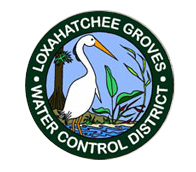The Loxahatchee Groves Water Control District Board of Supervisors discussed the condition of culverts Monday, focusing on their ability to move water during storms.
Supervisors are concerned that some of the culverts might not be able to function as well as they should.
The issue came up during a recent report on the condition of culverts by Loxahatchee Groves Planning & Zoning Board Member Keith Harris to the Roadway, Equestrian Trails & Greenway Advisory Committee, and at a subsequent Intergovernmental Coordination Committee meeting on April 23.
“It raised issues that are mainly town issues rather than water control district issues, but because we’re involved in the permits for bridges over the canals, he presented this at the [intergovernmental] meeting, leading up to further discussion with the town,” Supervisor John Ryan explained.
LGWCD Administrator Steve Yohe said many of the culverts and bridges are in poor condition, and the report raised issues regarding ownership of bridges and culverts, maintenance and replacement responsibility.
“At some point in time, this is sue is deserving of some kind of long-term replacement program,” Yohe said. “How that is funded is going to be a point of contention, because we’re talking tens of millions of dollars for replacing everything.”
Ryan said that former LGWCD Administrator Clete Saunier had told him once that about two-thirds of the canal crossings, whether they were steel beam, wood or culvert crossings, were built before there was a formal permitting process.
“Many of them have a lot of age associated with them,” Ryan said, adding that based on comments by Councilman Ron Jarriel and supervisors Don Widing and Dave DeMarois, who are all active or retired fire personnel, it is questionable whether they are passable by large vehicles such as fire trucks.
Ryan also pointed out that two crossings have failed, one when a cement truck attempted to cross it and another during Tropical Storm Isaac. He said the issues were resolved through private financing by the owners, but that ownership is not clear with many of the crossings.
“I think the study that was presented to the committee does need to be refined in terms of the details associated with the number and permit status of the bridges that exist,” Ryan said.
There is also an argument to be made that if the culvert is on a town road associated with gas tax revenue, Ryan said, the town could repair the culvert situation using gas tax money. “Well, we really leave that up to the town council,” he said.
Another issue is Palm Beach County’s role. When the district had concerns over the disrepair of culverts under Okeechobee Blvd., which is owned by the county, its response was that the county is responsible for the road surface, but not the culverts.
“The district has completed a contract to have the culverts inspected and cleaned out and repaired as necessary, and that work is drawing to a close,” Ryan said. “It’s part of a fairly comprehensive plan that we’ve discussed with the town of proceeding to restore the full design capacity of the canals and the culverts so that we can make the best argument possible to the Federal Emergency Management Agency (FEMA) as part of our community’s response to the draft of the flood maps.”
FEMA’s draft maps put virtually all properties in Loxahatchee Groves in a high-risk flood zone. “For people who have mortgages on their property, that’s going to necessitate flood insurance, and the premium cost is not inconsequential,” Ryan said.
Ryan noted that errors have been found in the initial FEMA maps that could remove most of the community from the high-risk flood zone.
Yohe said the agency will issue new maps in June, but preliminary reports indicate that most of Loxahatchee Groves will no longer be in the flood plain, except for some areas south of Tangerine Drive. “We know that is a problem area that needs to be addressed separately,” he said.
Ryan said every culvert in the district could possibly restrict the flow of flood water, which is the reason for permitting. “It will be a town issue to decide whether they will share in the form of a subsidy or be responsible for, or not be responsible for, the culvert crossings,” he said. “In the past, that has always been the responsibility of the landowners to provide access to their property.”
Ryan said he thought the district should cooperate with the town, possibly starting with a review of permitting history by the district.
During public comment, Jarriel said that he believes that the property owner should be responsible for culvert issues. LGWCD policy gives it the authority to remove a culvert if it is blocking water flow, and then the owner is responsible for getting a permit from the district and replacing it.
“The residents, as far as I’m concerned, are going to have to be responsible for their culverts,” Jarriel said. “But as far as doing research and telling people that they’ve got to replace their culverts because it’s not the proper size, but it doesn’t affect the flow of water, I definitely disagree with that. When it becomes a problem, the district will remove it, and they’ll have no choice but to put a new one in. They’ll have to pay for it unless the town decides otherwise.”
Ryan pointed out that the district had a detailed study done in 2000 by an engineering firm that showed concern for some of the culverts but rated most of them satisfactory.








